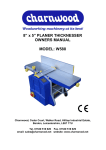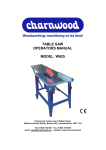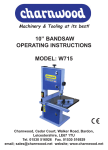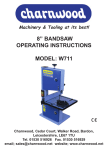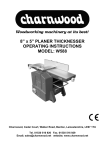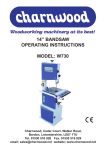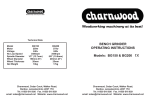Download Charnwood W616 Operating instructions
Transcript
10” TABLE SAW OPERATING INSTRUCTIONS MODEL: W616 Charnwood, Cedar Court, Walker Road, Hilltop Industrial Estate, Bardon, Leicestershire, LE67 1TU Tel. 01530 516 926 Fax. 01530 516 929 email: [email protected] website: www.charnwood.net 1 GENERAL SAFETY RULES WARNING: Do not attempt to operate the machine until you have read thoroughly and understood completely all instructions, rules, etc. contained in this manual. Failure to comply may result in accidents involving fire, electric shock, or serious personal injury. Keep this owner's manual and review frequently for continuous safe operation. 1. Know your machine. For your own safety, read the owner's manual carefully. Learn its application and limitations, as well as specific potential hazards pertinent to this machine. 2. Make sure all tools are properly earthed. 3. Keep guards in place and in working order. If a guard must be removed for maintenance or cleaning, make sure it is properly replaced before using the machine again. 4. Remove adjusting keys and spanners. Form a habit of checking to see that the keys and adjusting spanners are removed from the machine before switched it on. 5. Keep your work area clean. Cluttered areas and workbenches increase the chance of an accident.' 6. Do not use in dangerous environments. Do not use power tools in damp or wet locations, or expose them to rain. Keep work areas well illuminated. 7. Keep children away. All visitors should be kept a safe distance 8. from the work area. 9. Make workshop childproof. Use padlocks, master switches and remove starter keys. 10. Do not force the machine. It will do the job better and be safer at the rate for which it is designed. 11. Use the right tools. Do not force the machine or attachments to do a job for which they are not designed. Contact the manufacturer or distributor if there is any question about the machine's suitability for a particular task. 2 12. Wear proper apparel. Avoid loose clothing, gloves, ties, rings, bracelets, and jewellery which could get caught in moving parts. Non-slip footwear is recommended. Wear protective hair covering to contain long hair. 13. Always use safety glasses. Normal spectacles only have impact resistant lenses. They are not safety glasses. 14. Do not over-reach. Keep proper footing and balance at all times. 15. Maintain the machine in good condition. Keep the machine clean for best and safest performance. Follow instructions for lubrication and changing accessories. 16. Disconnect the machine from power source before servicing and when changing the blade. 17. Never leave the machine running unattended. Turn the power off. Do not leave the machine until it comes to a complete stop. 18. Do not use any power tools while under the effects of drugs, alcohol or medication. 19. Always wear a face or dust mask if operation creates a lot of dust and/or chips. Always operate the tool in a well ventilated area and provide for proper dust removal. Use a suitable dust extractor. ADDITIONAL RULES FOR CIRCULAR SAWS 1. Ensure that the saw table is clear of off-cuts, tools or anything else that might foul the work-piece. 2. If your saw has a dust extractor hose connected to the crown guard, ensure that it is held clear of the table and will not foul the work-piece as it passes over the table. 3. When cutting large sheets of material or long boards use one or more roller stand(s) to support the work or have a competent helper to support it as it feeds off the rear of the table. 4. Never use the saw without the riving knife and check that it is in line with the blade before using the saw. 5. Always use a brush to clear the table of dust or debris. NEVER use your hands, especially when the machine is running. 6. ALWAYS USE A PUSH STICK WHEN IT IS NECESSARY TO PUSH ANY PIECE OF MATERIAL OF SUCH SIZE THAT IT WOULD BRING YOUR HANDS WITHIN 30 CM OF THE BLADE. 3 7. Do not cut material that is badly warped or which has screws or nails in it 8. Be extra vigilant when cutting stock which has loose knots in it as these may fly out of the saw. 9. NEVER remove the table insert when the saw is running. 10. To avoid exposure to hazardous dust, do not use this saw without connecting it to a suitable dust extractor. 11. Always work with a sharp saw blade and feed the work at a rate suited to the thickness and hardness of the material. Note: This table saw has been designed and built solely as a woodworking machine. Do not modify it in any way or use for anything other than its designated purpose. Neither the manufactures nor the supplies are liable for any damage or injury caused by incorrect assembly, operation or electrical connection of this machine. Important: Risk of Injury! Never reach into the running saw blade. Wear Eye Protection Wear Ear Protection Specification Table size Table size with extensions Table height Motor (carbon brush) Blade diameter and bore Blade rotation speed (no load) Maximum depth of cut at 90o/45 o Cutting width with table extension Dust extractor hose connection Noise emission LPA Idle Weight Manufacturers Free Warranty Rating 440(w) x 660(d) mm 950(w) x 1060 (d) mm 830mm 1800W (2.5 hp), 240v single phase 254mm (10”) x 30mm 5700 rpm 75/60mm 450mm (17”) 40mm 93.2dB(A) 39 kg 1 year Hobby Rating Description Hobby: Suitable for Weekend DIY'ers and woodworking enthusiasts. Generally lighter weight machines with lower power ratings and smaller tooling capacities. Typically only ever used by one person for short periods of time or longer periods of time infrequently. Machinery should be well maintained in a clean, dry environment such as a home workshop, garage or timber shed. Expected maximum use of 100 hours annually. Please Note: Using a product in excess of its rating will void the manufacturers free warranty. 4 Unpacking Open the carton and carefully unpack all of the contents. Familiarise yourself with the parts and take the time to sort out the various types of nuts and bolts. Assembly Important note: These instructions relate to building a saw which is to be permanently mounted on its stand. If you have a small workshop, or will need to transport the saw, DO NOT bolt the rails to the body of the saw as shown in first two illustrations. Instead, fully assemble the floorstand first. The main body of the machine is designed to simply fit on top of the floorstand and is located by the rubber feet. Whenever possible it is recommended that the saw is bolted to the stand for increased stability. Leave all bolts finger tight until assembly of the legs is completed. Invert the machine and bolt one of the rails marked ‘B’ to the front underside as shown and the second one to the rear. Use the hex headed bolts and washers provided. 5 Do the same with the rails marked ‘A’, fitting these to the sides. Bolt on the four legs, ensuring that they fit outside the rails and that the narrow faces of the angles are to the front and rear. Use the short coach bolts, washers and nuts for this. Bolt on the four lower rails, noting that the ends are angled to match the splay of the legs. Use coach bolts as before. Place the four black rubber feet on the legs. Bolt the two stabilisers to the back legs. These prevent the possibility of the table tipping if a heavy board is resting on the rear extension table. Return the saw to a vertical position, true it up and tighten all the nuts and bolts. Attach the two side extension tables by pushing the round metal tubes into the corresponding holes in the end of the main table. 6 The side extensions are locked in place with the four large, black knobs which screw into the underside of the main table. Bolt the two blue support arms to the back of the saw. Loosely screw two bolts with washers into the threaded holes in the back edge of the main table. Loosely fit bolts, washers and nuts into the top end of the blue support arms. Fit the slots in the rear extension table over the heads of the bolts. Use a straight edge or the fence extrusion to level the rear extension table. The surface should be flush to the main table. Put the push stick in its holder, on the right hand side of the saw but please do not leave it there! Use it whenever a cut will bring your fingers closer than 30cm from the blade. 7 Remove the bolt and wing nut from the crown guard and fit the guard over the top of the riving knife. Replace the bolt and wing nut. Tighten them securely. Lay the blue section of the rip fence on the table. Using two long coach bolts, fit the thin metal guide bar to it, as shown and then slide the aluminium section over the guide bar. Screw a wing nut with washer onto each coach bolt. The aluminium extrusion is shown fitted with the taller side facing the blade. When cutting narrow and thin timber, the extrusion can be rotated 90 degrees clockwise to avoid it fouling on the saw guard. Fit the fence to the guide rail which runs along the front of the table. It can be locked in place with the locking handle. There is a magnifier to assist you with setting the fence. The sliding mitre fence is assembled in a similar manner, using the remaining guide bar and two short coach bolts and wing nuts. Fit one end of the hose to the crown guard. 8 Fit the other end of the extractor hose to the side of the T connector at the back of the machine, as shown. The diameter of the extraction outlet is 40mm. Charnwood has a range of adaptors available to convert it for attaching other diameters of hose. Using the Table Saw Controls Angle of Cut Adjusting Handle T Angle of Cut Locking Handle Depth of cut adjusting Hand wheel On/Off Switch On/Off Switch To turn the saw on, press the green button. Wait for the blade to reach its maximum speed of rotation before commencing with the cut. To turn the machine off again, press the red button. Cutting Depth Adjustments to the cutting depth should be made only when the saw is not running. Turn the hand wheel to set the blade to the required depth. Turn anticlockwise to raise the blade, turn clockwise to lower the blade. The blade height should always be set so that only the carbide tips of the blade (approx. 5mm) projects above the wood. 9 Cutting Width The rip fence is used to make longitudinal (with the grain) cuts. The fence can be fitted on either side of the saw blade. Set the fence to the required dimension with the help of the magnifier and scale. Clamp the fence in place by firmly pressing down the eccentric lever. To avoid kickback, the far end of the fence extrusion should be set correctly. The fence extrusion should be set so that the end is level with the centre of the saw blade. This allows the timber space to expand into, after the cut has been made. When cutting wider pieces the fence extrusion can be moved further towards the back of the blade, in a line projecting at roughly at 45 degrees out from the centre of the blade. Mitre Fence To cut across the grain, use the sliding mitre fence. Insert the fence into one of the T shaped slots in the table. To set 90 degrees or any other angle, undo the locking knob and rotate the quadrant to the desired angle. Lock the angle setting with the plastic knob. The mitre fence can be used on either side of the blade. If a longer fence is required, you can fit the extrusion from the rip fence onto the mitre fence. When setting the fence, take care to ensure the fence will not contact the blade. Angle of Cut Adjustments to the angle of cut should be made only when the saw is not running. To set the angle, turn the locking handle anticlockwise and then rotate the adjusting handle. Use the scale to set the desired angle the turn the locking handle clockwise. Making a cut Ensure there is enough space around the table for the work piece before starting the cut. Position your feet in a stable and balanced stance. When feeding the timber, place your hands on the section of timber being kept. Never hold the waste part of the timber. Never force timber through the saw, always let it cut at its own speed. When cutting narrow pieces - use the push stick. 10 Blade Removal and Replacement Always switch off and unplug the saw before removing or replacing the blade. A section of the table, to the right of the blade is removable to allow access to the interior of the saw. Remove the two screws (no. 2 Phillips) and lift out the panel. Use a 10mm spanner to hold the spindle stationary whilst using the 24mm spanner supplied, to unlock the securing nut. The blade can now be removed. Reverse this procedure to fit the new blade. Optional Accessories W616ET Right hand Extension Table - An additional extension table which fits onto the standard table and increases the maximum ripping width to 700mm (28"). W520 Universal Wheel Base – Allows the saw to be easily moved around the workshop, simply by pressing the foot pedals. W680 Dust Extraction It is highly recommended that a suitable Vacuum extractor or Dust collector is used with this Table Saw. Failure to do so will result in blockages inside the guarding and hoses. If blockages and built up dust are not removed it may cause damage and excessive wear to the saw blade and ultimately the failure of the motor. This will void the manufacturer’s warranty. 11 Routine Maintenance After every 20 hours of running, it is necessary to check the carbon brushes in the motor for wear. The carbon brushes must be replaced when the carbon block has less than 5mm of material remaining. Failure to replace them in time may cause damage to the motor armature, which can be expensive and difficult to replace. Remove the hose and the saw guard. Wind the blade down below the surface of the table. Invert the saw and remove the plastic cover from the base. Tilt the blade over to the 45 degree bevel position to gain better access to the brush cover. Use a flat screwdriver to remove the plastic cap. Use a small screw driver or pliers to pull out the brush. Check for wear, anything less than 5mm in length should be replaced. Push the new brush into place and refit the cap. Repeat for the second brush on the opposite side of the motor. 12 Troubleshooting Saw vibrates Check all nuts and bolts for tightness, check tilt is locked and check that blade is not damaged. Cuts are slow, wood is blackened Examine the blade. If any carbon tips are missing or broken the blade should be replaced. If the tips are blunt, the saw blade may be professionally sharpened. Saw stalls Feed rate too high, slow down. Tilt and/or blade height difficult to adjust Check tilt lock has been released, clean and lubricate mechanism. Rip fence is not parallel to blade Bring the fence to a straight line on the table top. Use a Hex key to undo the 2 adjusting screws, located in the blue painted section, and re-align the fence so it is parallel. Lower saw guard fills with dust It is essential to use a vacuum extractor or chip collector with this machine. If one is being used, check for blockages in the hose. Motor is running, but blade stationary Check the drive belt, replace if broken When pressing start, nothing happens Check fuse, check switch, Check carbon brushes & replace if worn Declaration of Conformity for CE Marking Charnwood Declare that Woodworking Circular Saw, Model W616 Conforms with the following Directives: Machinery Directive 2006/42/EC Low Voltage Directive 2006/95/EC EMC Directive 2004/108/EC And further conforms to the machinery example for which the EC type examination Certificate No. BM 50166724, AN 50166720 and AE 50243515 have been issued by TUV Rheinland LGA Products GmbH, Tillystrasse 2, 90431, Nurnberg. I hereby declare that equipment named above has been tested and found to comply with the relevant sections of the above referenced specifications. The machinery complies with all essential requirements of the directive. Signed: Dated: 26/11/2009 Richard Cook, Director 13 Location: Leicestershire EXPLODED DIAGRAM 14 Parts List Item 01 02 03 04 05 06 07 08 09 10 11 12 13 14 15 16 17 18 19 20 21 22 23 24 25 26 27 28 29 30 31 32 33 34 35 36 37 38 39 40 41 42 43 44 45 46 47 48 49 50 Part Blade retaining nut Washer Saw blade Washer Blade housing Screw Spring Riving knife support Shaft Hex. self locking nut Hex. nut, thin Threaded shaft Mounting plate Pointer Support plate Motor bracket Hex. nut Rack Hex. headed bolt Gear Screw Hex. nut Washer Large washer Front panel Angle scale Screw Angle adjustment knob Washer Locking knob Hand wheel, rise and fall Screw NVR switch Switch box Cable gland nut Shaft Circlip Screw Trunnion Bracket Cap head screw Motor Riving knife Riving knife mounting plate Hex. nut Side panel, left Panel, back Plug and cable Extraction connector Dust extractor hose QTY 1 1 1 1 1 4 1 1 1 4 4 1 1 1 1. 1 3 1 1 1 1 2 1 1 1 1 3 1 1 1 1 2 1 1 1 1 2 4 1 1 4 1 1 1 1 1 1 1 1 1 Item 51 52 53 54 55 56 57 58 59 60 61 62 63 64 65 66 67 68 69 70 71 72 73 74 75 76 77 78 79 80 81 82 83 84 85 86 87 88 89 90 91 92 93 94 95 96 97 98 99 15 Part Side panel, right Push stick retainer, front Push stick Push stick retainer, rear Cover plate, bottom Foot, machine Washer, large Screw Table extension, right Support rail, rear Washer Hex. nut Rubber foot, stand Bottom rail, short Coach bolt Bottom rail, long Top rail, short Top rail, long Rear table support Hex. headed bolt Table extension, rear Hex. headed bolt Crown guard Table Locking knob Access panel Screw Table extension, left Mitre gauge Rip fence support rail Rip fence extrusion Guide bar Hex. head bolt Cap head screw Rip fence base Pin Rip fence sliding base Spring plate Screw Locking handle Wing nut Leg Internal dust hose Hex. headed bolt Gasket Locking knob Slider bar Pivot pin Magnifier QTY 1 1 1 1 1 4 4 12 1 1 32 32 4 2 32 2 2 2 2 4 1 2 1 1 4 1 2 1 1 1 1 2 2 2 1 1 1 1 1 1 2 4 1 1 2 1 1 1 1 Charnwood, Cedar Court, Walker Road, Hilltop Industrial Estate, Bardon, Leicestershire, LE67 1TU Tel. 01530 516 926 Fax. 01530 516 929 email: [email protected] website: www.charnwood.net 16
















